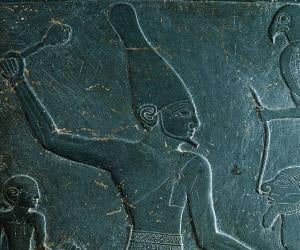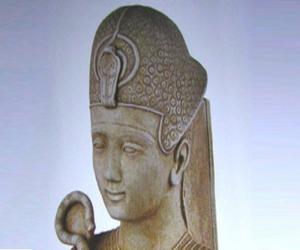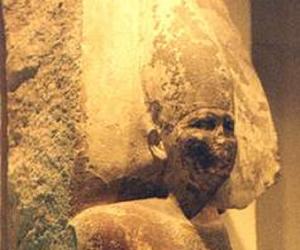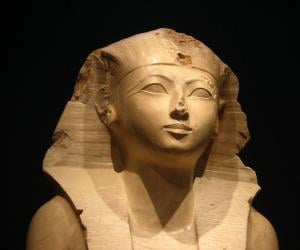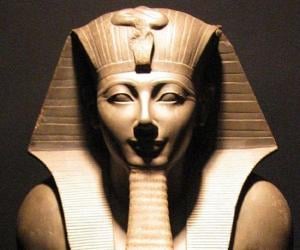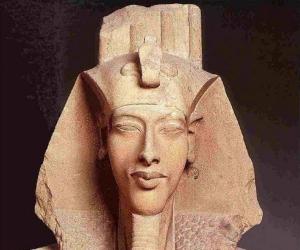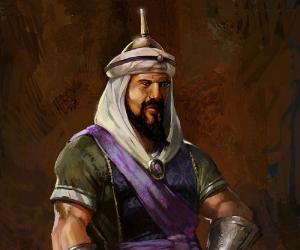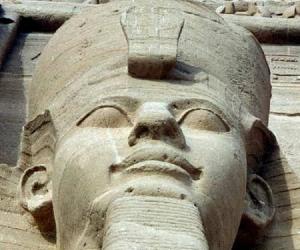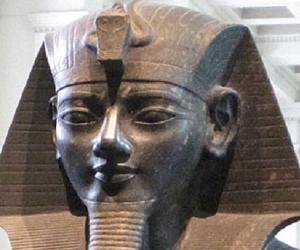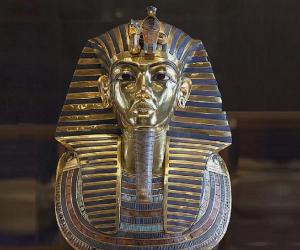Tracing the Identity & Family
The true identity of Narmer has been the subject of debates among Egyptologists for a long time. Most of them hold the view that Narmer and Pharaoh Menes is the same person.
According to ancient Egyptian written records, Menes is the first king of a unified Egypt. The reason Narmer is identified as Menes is that the Narmer Palette shows him as the unifier of Egypt, wearing both the white Hedjet Crown of Upper Egypt and the Red Deshret Crown of Lower Egypt.
Two necropolis seals, found from the Umm el-Qa'ab cemetery of Abydos, are also used as proofs to demonstrate that Narmer was the first king of the First Dynasty. Most Egyptologists generally believe 3,100 BC to be the beginning of his reign. The other popular view is that he ruled sometime between 3,273 and 2,987 BC. This theory is supported by both the historical method and radiocarbon dating.
Most sources agree that his father was Ka, a Protodynastic pharaoh of Upper Egypt belonging to Dynasty 0. Ka reigned over Thinis in the first half of the 32nd century BC and is believed to be the immediate successor to Iry-Hor. He is possibly the first Egyptian ruler to have a serekh inscribed on a number of artefacts, a fact that has led many to the conclusion that it was innovated during his reign.
Another king from the Protodynastic Period of Upper Egypt who has been hypothesised as Narmer’s immediate predecessor is Scorpion II. He was one of the two rulers of Upper Egypt during Naqada III, the other being Scorpion I, who is believed to be the unifier of Upper Egypt. Scorpion II presumably ruled in the intermediate period between the reigns of Ka, his predecessor, and Narmer, his successor.
Continue Reading Below
The Narmer Palette
Discovered in 1897 or 1898 by British archaeologists James E. Quibell and Frederick W. Green, the Narmer Palette or Narmer's Victory Palette or the Great Hierakonpolis Palette is a 63 centimetres tall (2.07 ft), shield-shaped, ceremonial palette, carved from a single piece of flat, soft dark grey-green siltstone. It is engraved on both sides and contains some of the earliest hieroglyphics ever found.
On one side, Narmer can be seen wearing the crowns of both Upper and Lower Egypt, implying that, at one point during his reign, he ruled over the entire country. This side of the palette also provides the Egyptologists with his name, which is comprised of two symbols, a catfish (n'r) and a chisel (mr). As a result, his name is read as Narmer. Some believe that the literal translation of the entire word is “raging catfish”. However, this theory is highly contested.
On the other side, a single, distinctive depiction of Narmer with his war club raised is engraved. He is about to strike down an enemy, who he is holding by the hair. In front of him and above the enemy, there is a depiction of a falcon, which symbolizes Horus, a deity who has been closely associated with the pharaohs. A servant can be seen behind him holding his sandals.
On both the sides, Narmer is depicted wearing several other pieces of royal regalia besides the crowns, including the royal kilt and a bull’s tail that is hanging from the back of his kilt.
History & Reign
For the majority of the Protodynastic Period, Egypt was divided into two parts, Upper Egypt (the south) and Lower Egypt (the north, near the Mediterranean Sea). Upper Egypt was more developed and had some of the most urbanised cities in the world at the time, including Thinis, Hierakonpolis, and Naqada.
Lower Egypt was comparatively a rural region. However, it had a strong economy due to its fertile agricultural fields.
The two regions had experienced parallel growth since the hunter-gatherer tribes moved out of Sahara due to the gradual desertification and settled down in and around the Nile River basin.
Upper Egypt experienced more development than its neighbour probably because of its trade relations with other cultures. The population of this region was most likely growing quite fast as well. All these factors eventually prompted its rulers to venture out beyond its borders.
Scorpion I preceded Narmer by about 200 years and is believed to have unified Upper Egypt. According to a 5,000-year-old graffito that has been recently found in the Theban Desert Road Survey, Scorpion I defeated another Protodynastic ruler, possibly the king of Naqada.
Continue Reading Below
His tomb was discovered previously in the royal cemetery of Abydos. In it, many small ivory plaques were found. Marked with one or more hieroglyph-type scratched images, each of these plaques has a hole in it to tie it to something. They probably denote the names of towns and regions that paid offerings and tributes to Scorpion I. Some of these indicate that Scorpion I’s army had made it to the Nile Delta.
Even Narmer’s immediate predecessors, Ka, Iry-Hor, and Scorpion II, had unified Egypt to some extent. Ka and Iry-Hor’s inscriptions have been found in Lower Egypt and Canaan, which was accessed through Lower Egypt at the time. However, compared to Narmer, whose serekhs have been discovered in ten sites in Lower Egypt and nine sites in Canaan, his predecessors had left fewer inscriptions beyond Upper Egypt.
This disparity is yet another proof that Narmer was the first ruler of the entire country. It is probable that the unification began before Narmer’s rule but it was definitely completed during his reign.
According to Egypt’s classical tradition, a pharaoh named Menes was the unifier of Egypt and most Egyptologists agree that Narmer and Menes is the same person. However, a few identity Narmer’s successor, Hor-Aha, as Menes.
One of the reasons for this confusion is while “Narmer” is regarded as a Horus or serekh name, “Menes” is thought to be a Sedge and Bee name. During the New Kingdom era, the personal names of the kings were begun to be listed and almost all those lists started with Menes or started with divine and/or semi-divine sovereigns, with Menes being hailed as the first “human king”.
Two necropolis seals, which were discovered in 1985 and 1991 in Abydos, list all the eight kings of the First Dynasty in the correct order. On both of them, Narmer’s name appears on the top, providing a strong evidence for the theory that he was the first king of the First Dynasty, which, in turn, establishes him as Menes as well.
Besides the Narmer Palette, several other pieces of evidence exist that show that Egypt was unified under Narmer. In 1993, a “year label” of Narmer was found in Abydos, showing similar events as the palette and thereby proving, for many Egyptologists, that the depictions of the palette are historical events.
The Narmer Macehead in the “main deposit” in the temple area of Hierakonpolis depicts a king (Narmer) wearing the Red Deshret Crown.
During Narmer’s reign, Egypt had economic interests in Canaan. Many pottery shreds that have been found in the southern part of the region are either from pots made in Egypt itself and brought to Canaan or made in the Egyptian style from local materials. This probably indicates that there were Egyptian settlements in the region during this period.
Continue Reading Below
Twenty serekhs that can be attributed to Narmer have been discovered in the Canaan region to date. However, the authenticity of at least seven of them is highly doubtful.
Neithhotep & Hor-Aha
Neithhotep is a very important figure in Egyptian history. At one point, she was believed to be a male ruler due to her large mastaba and the royal serekh around her name on several seal impressions.
It was only when scholars became more proficient in reading Egyptian writings that they understood that she was actually a woman of extraordinary rank. Until recently, Egyptologists thought that she was Narmer’s queen.
There are conflicting theories about where Neithhotep was originally from. The meaning of her name, "Neith is satisfied", implies that she was a princess of Lower Egypt as Neith was the patron goddess of the town of Sais, which was situated in the Western Delta, a region that Narmer most likely conquered during his expedition to Lower Egypt. The marriage presumably took place to strengthen the bond between the two regions.
However, Neithhotep’s tomb was discovered in Naqada, which has led some Egyptologists to believe that she was a Naqada princess. In 2012, new evidence was found that contradicted everything that had been known about her. It shows that she was, in fact, the wife Hor-Aha, the successor of Narmer. After Hor-Aha’s death, she assumed the regency for their son, Djer.
